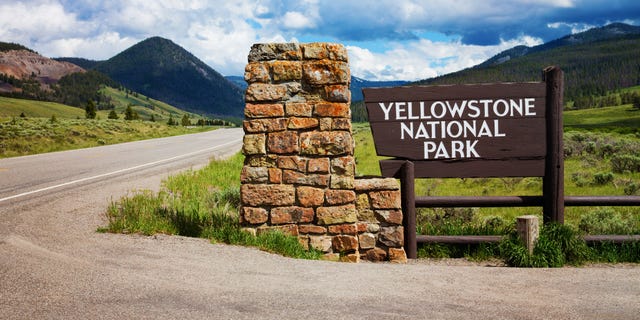
One of the entrances to Yellowstone National Park is shown here.
Fox News
As the U.S. celebrates — all year long — a milestone anniversary of this treasured American national park, here's a collection of fascinating facts, featured players, and sometimes-forgotten but always interesting details, numbers, quotes, and more connected to our remarkable national preserve.
Yellowstone's beginnings
1. Established on March 1, 1872, Yellowstone National Park became the first national park in the U.S.
2. President Ulysses S. Grant signed the Yellowstone Protection Act into law for "the benefit and enjoyment of the people."
3. President Grant never visited Yellowstone; but he explored areas of the American West such as Washington state, Nebraska, the Dakotas, and Colorado, all of which piqued his interest in wildlife preservation.
4. Archeological sites, trails, and oral histories prove that humans have inhabited Yellowstone for the last 11,000 years.
5. Yellowstone National Park was the site of 27 Native American tribes for more than 10,000 years before the park was founded.
6. The first organized European American expedition explored Yellowstone in 1870.
7. The railroad arrived at Yellowstone in 1883 — expanding accessibility to the park.
8. The U.S. Army was put in charge of watching over the park in 1886.
Yellowstone National Park stretches for 3,472 square miles and across more than 2.2 million acres — making it larger than Rhode Island and Delaware combined.
9. In the early 1900s, the federal government launched a campaign that killed off nearly all predatory species and bison.
10. The National Park Service was founded in 1916.
Yellowstone's geography
11. Yellowstone exists across 3 states — mostly in Wyoming (96%) and in Montana (3%) and Idaho (1%) as well.
12. The highest point of Yellowstone National Park is 11,358 feet, at Eagle Peak.
13. The lowest point of Yellowstone National Park is 5,282 feet at Reese Creek.
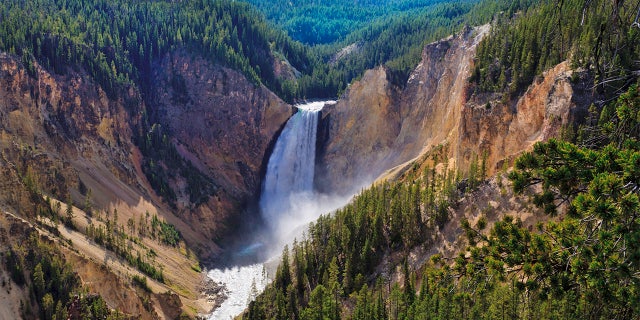
15. The park is located at the convergence of the Great Plains, Great Basin and Columbia Plateau.
16. Yellowstone National Park is bigger than 2 U.S. states. It stretches for 3,472 square miles and across more than 2.2 million acres — making it larger than Rhode Island and Delaware combined, according to Yellowstone.org.
Yellowstone's landscape
17. Yellowstone Lake is the largest high-elevation lake in North America, at 7,733 feet above sea level.
18. Yellowstone Lake measures 131.7 square miles of surface area and 141 miles of shoreline.
19. Yellowstone Lake reaches a maximum depth of 430 feet.
20. Yellowstone has over 1,000 native flowering species and 225 species of invasive plants.
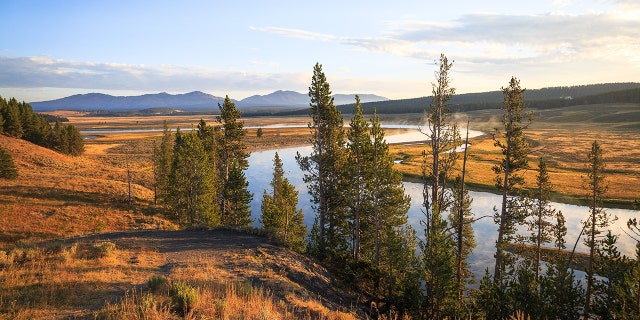
21. More than 80% of Yellowstone’s forests are made up of lodgepole pine.
22. Yellowstone is classified under the highest category (Class 1) of clean air protection under the Clean Air Act (1970).
23. Across Yellowstone’s more than 2.2 million acres, about 290 waterfalls can be found.
24. The Grand Canyon of the Yellowstone River in Hayden Valley is roughly 20 miles long, flowing from the 109-foot Upper Falls.
25. Lower Falls of the Yellowstone River is the tallest waterfall near a road, measuring 308 feet.
26. The canyon’s Lower Falls flows about 63,500 gallons of water per second over the falls at peak runoff.
27. The Yellowstone Volcano Observatory (YVO) was established in 2001 to monitor volcanic activity.
28. Yellowstone sits atop an active volcano, yet an eruption in the next few hundred years is unlikely, according to YVO research.
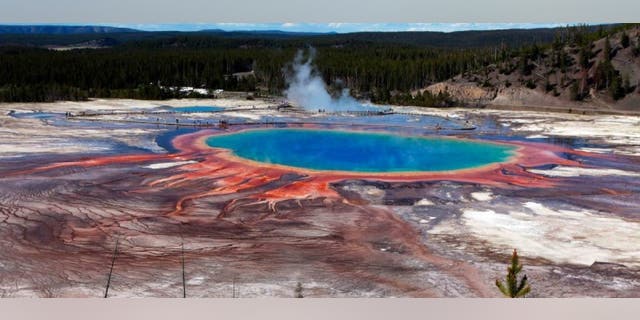
29. The Yellowstone Super Volcano is one of the largest calderas in the world, measuring 45 x 30 miles.
30. Yellowstone has more than 10,000 hydrothermal features, including geysers, hot springs, mud pots and fumaroles.
There are more than 500 active geysers in Yellowstone.
31. Grand Prismatic Spring is Yellowstone's largest hot spring, measuring 200-330 feet in diameter and more than 121 feet deep.
32. Hot springs have killed or injured more people in Yellowstone than any other natural features.
33. Boardwalks and trails have been laid down for visitor safety in thermal areas, since more than 20 people have died from severe burns.
Yellowstone's wildlife and ecosystem
42. The park is home to the largest population of mammals in the lower 48 states.
43. There are 67 different species of mammals in the Yellowstone area.
44. Yellowstone requires wildlife watchers to stay 100 yards away from predatory species and 25 yards from all other animals.
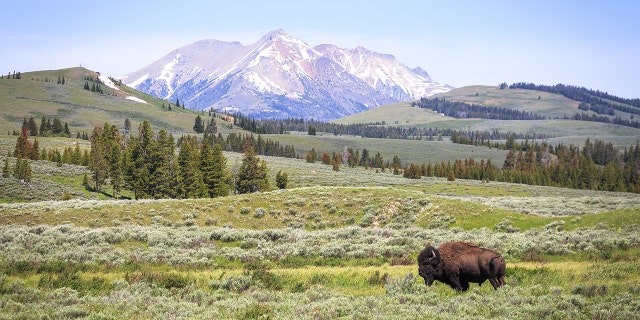
45. Yellowstone has been nicknamed the "American Serengeti" for its unpredictable wildlife patterns and vast ecosystem, according to Natural Habitat Adventures.
46. The last known Yellowstone wolf pack was exterminated in 1926, according to National Geographic.
47. Forty-one wolves were reintroduced to Yellowstone in the mid-'90s to reestablish ecosystem balance.
48. Grizzly bear and mountain lion populations grew due to increased protection in the 90s, as well.
Yellowstone is home to the largest free-ranging herd of bison in North America.
49. Grizzly bears in the state of Wyoming are federally managed and endangered, with only an estimated 600 to 800 bears left. Canada lynx and grizzly bears are both threatened species.
50. Moose, the largest member of the deer family, can stand over six feet tall.

51. Moose antlers can weigh up to 25 pounds each and span up to six feet wide.
52. Moose can run 30 to 35 miles an hour — a lot faster than humans, according to Jackson Hole EcoTour Adventures founder Taylor Phillips.
53. Breeding season for Yellowstone elk takes place in late September, early October when lots of bugling can be heard.
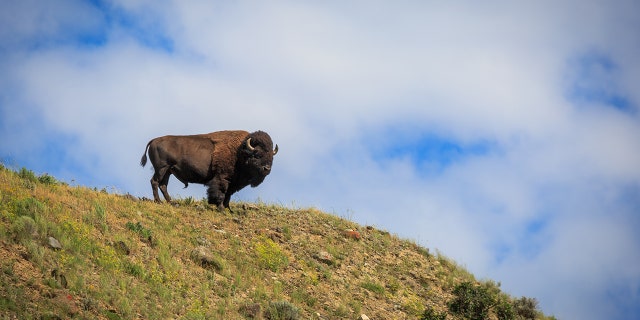
56. Yellowstone is home to the largest free-ranging herd of bison in North America.
57. Yellowstone has recovered a population of about 3,000 to 4,000 bison per year since the extermination of an estimated 60 million in the 1800s.
58. Bison are the largest land mammal in North America, with the biggest male bison weighing up to 2,000 pounds.
59. A bison attack occurs every year at Yellowstone — patrons are tossed by a bison’s horns, according to Phillips.
61. An estimated 100 colonies of beavers are native to Yellowstone as of 2015.
62. Beavers, the largest rodent in North America, can measure up to 40 inches long and weigh up to 60 pounds.
63. As of 2019, 285 bird species — 150 of them nesting — could be spotted in Yellowstone.
64. Yellowstone is home to 16 fish species, 6 reptile species and 5 amphibian species.
65. Cutthroat trout were the dominant Yellowstone fish species even prior to Euroamerican settlement.

66. Some 50,000 visitors out of 4 million visit Yellowstone annually to fish.
Yellowstone's explorations
71. Lamar Valley is considered the best site to view wildlife in Yellowstone by Outdoor Project.
72. Rocky terrain species like bighorn sheep, bison, antelope and deer can be best spotted in the Tower-Roosevelt area aloft Yellowstone’s cliffs.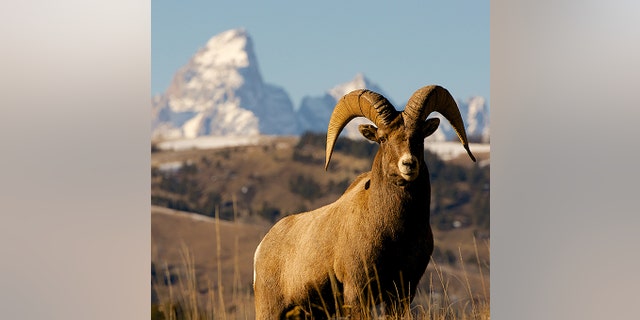
73. Grizzly bears can be spotted in Hayden Valley in the spring and early summer months — along with bison, coyotes, and various birds.
74. Canyon Village’s Mount Washburn, a popular place for a day hike, has a peak elevation of 10,219 feet.
75. Mount Washburn has panoramic views for 20 to 50 miles.

76. Mount Washburn, the remnant of volcanic activity, was named after the 1870s Washburn-Langford-Doane expedition leader General Henry Washburn.
77. Wildflower season begins at lower elevations in April and continues upward through July.
78. Dunraven Pass is a popular destination for visitors to view carpets of wildflowers.
Yellowstone's recreation and visitation
79. There are about 3,200 employees working for concessioners during the summer peak at Yellowstone.
80. Yellowstone National Park has 11 visitor centers, museums, and contact stations.
81. The park has 9 hotels and lodges, with more than 2,000 rooms.
82. Yellowstone has 7 campgrounds managed by the National Park Service (NPS) and 5 concession-operated campgrounds.
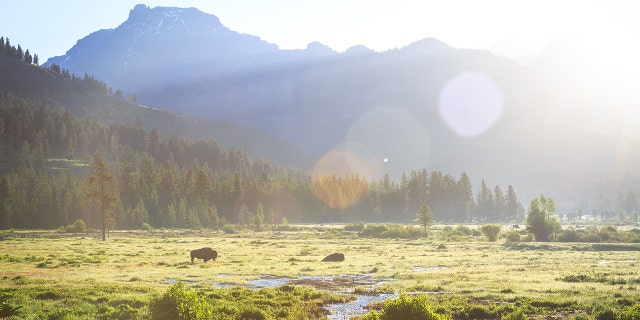
83. Yellowstone has 52 picnic areas and one marina.
84. The park has a total of 466 miles of paved roads and more than 15 miles of boardwalk.
85. There are approximately 1,000 miles of hiking trails throughout the park.
86. Yellowstone has 35 ski and snowshoe trails.
87. Yellowstone's Grand Loop is 142 miles of road; it curves in a figure-8 throughout the park, according to Planet Ware.
88. Driving the entire loop can take 4 to 7 hours, depending on traffic.
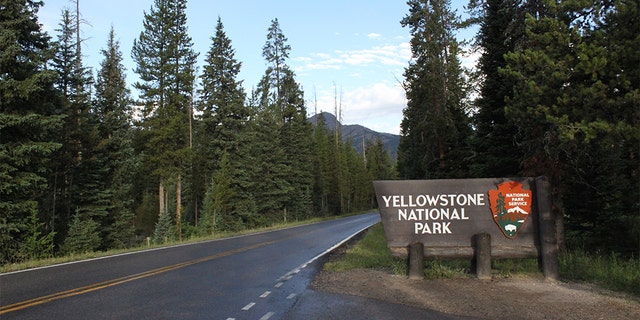
89. Scattered throughout Yellowstone’s back country are 301 campsites and 92 trailheads.
90. The year 2021 marked Yellowstone’s busiest year on record, at 4,860,537 visitors — up 28% from 2020 (the year the coronavirus pandemic hit the U.S.).
91. July 2021 was the most visited month that year — and the month of July continues to be the most popular month for visitors every year.
92. In July 2021, the park exceeded 1 million visitors in that month alone, which marked the first time it had done so in recorded history.
Yellowstone's weather
93. Yellowstone receives about 10 inches of precipitation annually at the north boundary and about 80 inches in the southwest corner.
94. Yellowstone hit a record-high temperature of 99 degrees Fahrenheit in Mammoth Hot Springs in 2002.
95. The park hit a record-low temperature of -66 degrees Fahrenheit in 1933 at West Entrance, Riverside Station.

96. The average daily temperature in Yellowstone is a high of 80 degrees and a low of 9 degrees.
97. From April to October, the Milky Way is visible over Yellowstone.
98. The Northern Lights (aurora borealis) appear once or twice a year.
99. Average annual park-wide snowfall is 150 inches, but the snow can reach 200-400 inches at higher elevations, according to Yellowstone National Park Lodges.

103. More than $120 million was spent fighting the total of 51 wildfires in 1988.
104. All new natural fires after July 15, 1988, were ordered to be suppressed manually.
105. A quarter-inch of snow on Sept. 11, 1988, put a final stop to the fires that year.
Yellowstone's landscape has been naturally shaped by 14,000 years of wildfires.
106. Wildfires in 2016 at Yellowstone burned 70,285 acres of land.
Yellowstone's research and history
109. More than 1,800 archeological sites are known to be located within the park.
110. Over 20,000 museum items, 30 historic vehicles — plus 20,000 rare books, manuscripts and periodicals — and millions of archived documents are housed at Yellowstone’s research centers.
111. The Yellowstone Research Library collects published and unpublished materials related to the national park for public enjoyment.
112. The library is hosting a Sesquicentennial Summer Reading Challenge for the 150th anniversary — challenging participants to read 1,872 minutes between April and August.
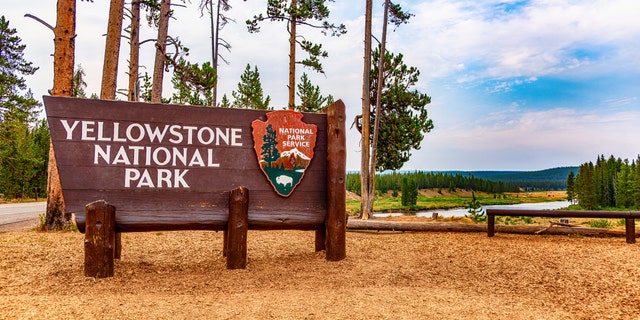
116. The Old Faithful Inn has been considered the world's largest log cabin open to lodging guests and a dining room that feeds the public.
117. The 1,170-mile Nez Perce National Historic Trail — stretching from Wallowa Lake, Oregon, to the Bear’s Paw Mountains in Montana — cuts through Yellowstone Park.
118. The trail founded in 1986 and managed by the U.S. Forest Service pays tribute to the Nez Perce tribe that was uprooted and killed by settlers in 1877.
There are more than 900 historic buildings in Yellowstone.
119. Mission 66 revitalization efforts began in 1955 to mend deterioration that occurred during WWII.
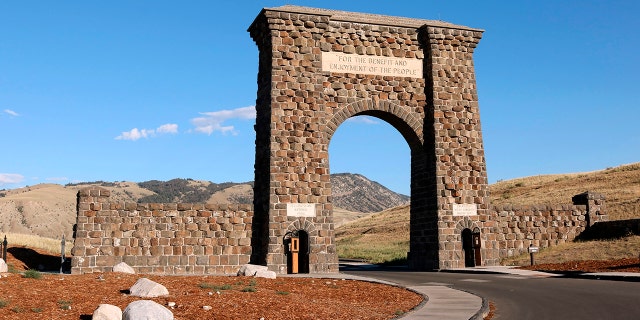
126. Arch construction took about 6 months and cost about $10,000.

129. A time capsule put together by local Masons was placed inside the arch; it reportedly contains a Bible, a picture of Roosevelt, Masonic documents, newspapers, coins and other belongings.
130. Roosevelt never returned to Yellowstone after the dedication and never witnessed the completed arch.
Harding snapped a photo with Yellowstone’s famous black bear Jesse James.
131. President Woodrow Wilson approved the National Park Service Organic Act put forward by Congress on Aug. 25, 1916, which marked the beginning of the National Park Service.
132. President Warren Harding visited Yellowstone National Park in 1923 as the first stop on his national parks’ tour, according to the White House Historical Association. (He died on Aug. 2, 1923.)
133. Harding snapped a photo with Yellowstone’s famous black bear Jesse James.
134. Alongside reporters and a camera crew, Harding told the public, "Commercialism will never be tolerated here as long as I have the power to prevent it."
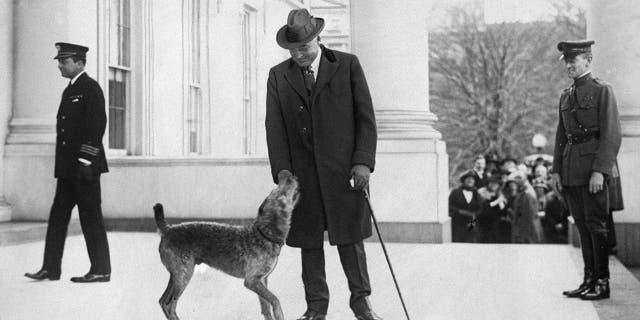
135. President Calvin Coolidge and his first lady, Grace Coolidge, visited Yellowstone on Aug. 22, 1927.
136. Coolidge caught 15 fish — when instructed in fishing with spinners by a park ranger — in the Firehole River near Old Faithful.
137. President Gerald R. Ford worked as a park ranger at Yellowstone National Park as a youth during the summer of 1936.
138. Ford returned to Yellowstone as president on Aug. 29, 1976, to renew national interest in America’s parks.
Yellowstone's celebrity status
139. Yellowstone Club is the world’s only private ski, golf and adventure community.
140. The club situated in the Rocky Mountains, located north of the park, spans 15,200 acres in Big Sky, Montana.
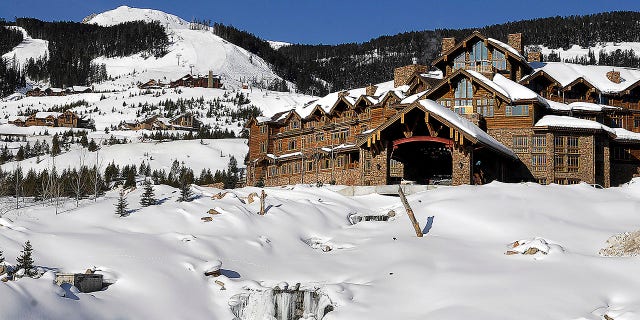
141. Luxury Yellowstone Club real estate and custom residencies are available for purchase.
142. Celebrity Yellowstone Club members include Bill and Melinda Gates, Tom Brady and Gisele Bundchen, and Justin Timberlake and Jessica Biel, according to Celebrity Net Worth.
The Season 4 finale of "Yellowstone" broke major records, with more than 11 million total viewers.
143. Paramount Network's popular drama "Yellowstone" launched in 2018. It highlights the modern-day struggle of ranchers who have owned land for centuries.
144. The Season 4 finale of "Yellowstone" broke major records, with more than 11 million total viewers, according to Deadline.
145. "Yellowstone" star Kevin Costner is set to launch the "Yellowstone: One-Fifty" series on Fox Nation later this year.
Yellowstone's noted quotes
146. Theodore Roosevelt said, "There can be nothing in the world more beautiful than the Yosemite, the groves of the giant sequoias and redwoods, the Canyon of the Colorado, the Canyon of the Yellowstone, the Three Tetons; and our people should see to it that they are preserved for their children and their children’s children forever, with their majestic beauty all unmarred."
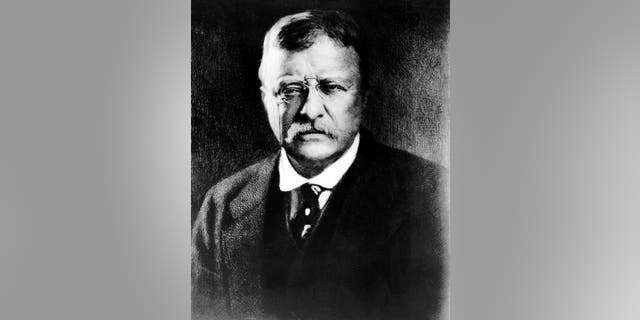
147. "Maybe you weren’t born with a silver spoon in your mouth, but like every American, you carry a deed to 635 million acres of public lands," said Rep. John Garamendi, D-Calif. "That’s right. Even if you don’t own a house or the latest computer on the market, you own Yosemite, Yellowstone, the Grand Canyon, Golden Gate National Recreation Area, and many other natural treasures."
148. "Yellowstone, of all the national parks, is the wildest and most universal in its appeal," said Brigham Young University associate professor of history Susan Rugh. "Daily new, always strange, ever full of change, it is nature’s wonder park. It is the most human and the most popular of all parks."
149. Naturalist John Muir wrote, "To everybody over all the world, water is beautiful forever, whether falling upward into the sky in snowy geysers, or downward into deep resounding canyons, or gliding and resting in calm rivers and lakes."
150. "The Yosemite, the Yellowstone, the Grand Canyon are national properties in which every citizen has a vested interest; they belong as much to the man of Massachusetts, of Michigan, of Florida, as they do to the people of California, of Wyoming, and of Arizona," said Stephen Mather, first director of the national parks.
Sources for the material in this article include the National Park Service, Yellowstone National Park, Yellowstone National Park Lodges, Jackson Hole EcoTour Adventures, Outdoor Project, National Geographic, Natural Habitat Adventures, White House Historical Association, Yellowstone Club, Planet Ware, and Celebrity Net Worth.
Fox News Writer Angelica Stabile is a lifestyle writer for Fox News Digital. Follow her on Twitter at @atstabile.
American history, science, nature, and more are celebrated within this stunning national treasure
Happy 150th birthday,
Yellowstone National Park!
As the U.S. celebrates — all year long — a milestone anniversary of this treasured American national park, here's a collection of fascinating facts, featured players, and sometimes-forgotten but always interesting details, numbers, quotes, and more connected to our remarkable national preserve.
As Yellowstone turns 150 this year,
check out these 150 facts — and share them!
Yellowstone's beginnings
1. Established on March 1, 1872, Yellowstone National Park became the first national park in the U.S.
2. President Ulysses S. Grant signed the Yellowstone Protection Act into law for "the benefit and enjoyment of the people."
3. President Grant never visited Yellowstone; but he explored areas of the American West such as Washington state, Nebraska, the Dakotas, and Colorado, all of which piqued his interest in wildlife preservation.
4. Archeological sites, trails, and oral histories prove that humans have inhabited Yellowstone for the last 11,000 years.
5. Yellowstone National Park was the site of 27 Native American tribes for more than 10,000 years before the park was founded.
6. The first organized European American expedition explored Yellowstone in 1870.
7. The railroad arrived at Yellowstone in 1883 — expanding accessibility to the park.
8. The U.S. Army was put in charge of watching over the park in 1886.
Yellowstone National Park stretches for 3,472 square miles and across more than 2.2 million acres — making it larger than Rhode Island and Delaware combined.
9. In the early 1900s, the federal government launched a campaign that killed off nearly all predatory species and bison.
10. The National Park Service was founded in 1916.
Yellowstone's geography
11. Yellowstone exists across 3 states — mostly in Wyoming (96%) and in Montana (3%) and Idaho (1%) as well.
12. The highest point of Yellowstone National Park is 11,358 feet, at Eagle Peak.
13. The lowest point of Yellowstone National Park is 5,282 feet at Reese Creek.
14. The park is comprised of forest (80%), grassland (15%) and water (5%).

Yellowstone Falls — Grand Canyon of the Yellowstone — in Yellowstone National Park.
15. The park is located at the convergence of the Great Plains, Great Basin and Columbia Plateau.
16. Yellowstone National Park is bigger than 2 U.S. states. It stretches for 3,472 square miles and across more than 2.2 million acres — making it larger than Rhode Island and Delaware combined, according to Yellowstone.org.
Yellowstone's landscape
17. Yellowstone Lake is the largest high-elevation lake in North America, at 7,733 feet above sea level.
18. Yellowstone Lake measures 131.7 square miles of surface area and 141 miles of shoreline.
19. Yellowstone Lake reaches a maximum depth of 430 feet.
20. Yellowstone has over 1,000 native flowering species and 225 species of invasive plants.


The sun begins to set on the Hayden Valley landscape at Yellowstone State Park.
21. More than 80% of Yellowstone’s forests are made up of lodgepole pine.
22. Yellowstone is classified under the highest category (Class 1) of clean air protection under the Clean Air Act (1970).
23. Across Yellowstone’s more than 2.2 million acres, about 290 waterfalls can be found.
24. The Grand Canyon of the Yellowstone River in Hayden Valley is roughly 20 miles long, flowing from the 109-foot Upper Falls.
25. Lower Falls of the Yellowstone River is the tallest waterfall near a road, measuring 308 feet.
26. The canyon’s Lower Falls flows about 63,500 gallons of water per second over the falls at peak runoff.
Yellowstone's Super Volcano and geothermal features
27. The Yellowstone Volcano Observatory (YVO) was established in 2001 to monitor volcanic activity.
28. Yellowstone sits atop an active volcano, yet an eruption in the next few hundred years is unlikely, according to YVO research.

The Grand Prismatic Spring, the largest in the United States and third-largest in the world, is seen in Yellowstone National Park, Wyoming, on June 22, 2011.
29. The Yellowstone Super Volcano is one of the largest calderas in the world, measuring 45 x 30 miles.
30. Yellowstone has more than 10,000 hydrothermal features, including geysers, hot springs, mud pots and fumaroles.
There are more than 500 active geysers in Yellowstone.
31. Grand Prismatic Spring is Yellowstone's largest hot spring, measuring 200-330 feet in diameter and more than 121 feet deep.
32. Hot springs have killed or injured more people in Yellowstone than any other natural features.
33. Boardwalks and trails have been laid down for visitor safety in thermal areas, since more than 20 people have died from severe burns.
34. There are more than 500 active geysers in Yellowstone — that's more than half of all the geysers in the world.
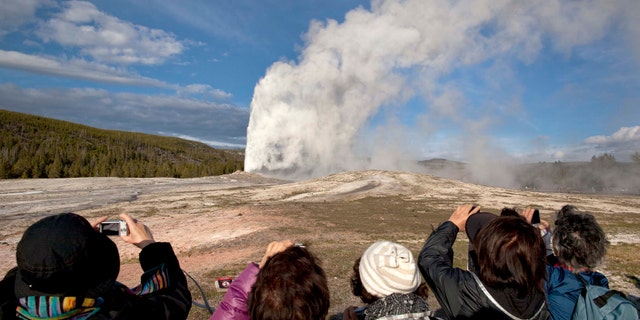
35. The Upper Geyser Basin has the highest concentration of geysers in the world, including Old Faithful, the Giantess Geyser, the Grand Geyser and the Morning Glory Pool.
36. Yellowstone is home to cone geyser Old Faithful — one of the most famous geothermal features in the world, according to Outdoor Project.
37. Old Faithful got its name from the way it faithfully erupts every 45 to 125 minutes.
38. Eruptions at Old Faithful last from 3 to 10 minutes — and can blast up to 185 feet high.

Tourists snap pictures of Old Faithful erupting late in the afternoon in Yellowstone National Park on May 11, 2011.
35. The Upper Geyser Basin has the highest concentration of geysers in the world, including Old Faithful, the Giantess Geyser, the Grand Geyser and the Morning Glory Pool.
36. Yellowstone is home to cone geyser Old Faithful — one of the most famous geothermal features in the world, according to Outdoor Project.
37. Old Faithful got its name from the way it faithfully erupts every 45 to 125 minutes.
38. Eruptions at Old Faithful last from 3 to 10 minutes — and can blast up to 185 feet high.
39. Old Faithful eruptions can dispel anywhere from 3,700 to 8,400 gallons of nearly boiling water.
40. Hikers can visit Yellowstone’s Boiling River, located at the Wyoming-Montana border, and soak in the natural hot springs that are cooled down by the Gardner River.
41. The Mammoth Hot Springs on the east flank of the 8,012-foot tall Terrace Mountain have created natural travertine steps, such as Minerva Terrace.
41. The Mammoth Hot Springs on the east flank of the 8,012-foot tall Terrace Mountain have created natural travertine steps, such as Minerva Terrace.
Yellowstone's wildlife and ecosystem
42. The park is home to the largest population of mammals in the lower 48 states.
43. There are 67 different species of mammals in the Yellowstone area.
44. Yellowstone requires wildlife watchers to stay 100 yards away from predatory species and 25 yards from all other animals.

A bison is spotted out in the wide-open Wyoming landscape.
45. Yellowstone has been nicknamed the "American Serengeti" for its unpredictable wildlife patterns and vast ecosystem, according to Natural Habitat Adventures.
46. The last known Yellowstone wolf pack was exterminated in 1926, according to National Geographic.
47. Forty-one wolves were reintroduced to Yellowstone in the mid-'90s to reestablish ecosystem balance.
48. Grizzly bear and mountain lion populations grew due to increased protection in the 90s, as well.
Yellowstone is home to the largest free-ranging herd of bison in North America.
49. Grizzly bears in the state of Wyoming are federally managed and endangered, with only an estimated 600 to 800 bears left. Canada lynx and grizzly bears are both threatened species.
50. Moose, the largest member of the deer family, can stand over six feet tall.

A moose stands alert over brush in Wyoming.
51. Moose antlers can weigh up to 25 pounds each and span up to six feet wide.
52. Moose can run 30 to 35 miles an hour — a lot faster than humans, according to Jackson Hole EcoTour Adventures founder Taylor Phillips.
53. Breeding season for Yellowstone elk takes place in late September, early October when lots of bugling can be heard.
54. Dominant bull elk require a harem of females, ranging from 5 to 90 at a time.
55. Elk have a tendency to ram into car doors on Yellowstone roadways during breeding season, due to their increased testosterone.
55. Elk have a tendency to ram into car doors on Yellowstone roadways during breeding season, due to their increased testosterone.

A bull bison stands on top of a mountain in Yellowstone National Park.
56. Yellowstone is home to the largest free-ranging herd of bison in North America.
57. Yellowstone has recovered a population of about 3,000 to 4,000 bison per year since the extermination of an estimated 60 million in the 1800s.
58. Bison are the largest land mammal in North America, with the biggest male bison weighing up to 2,000 pounds.
59. A bison attack occurs every year at Yellowstone — patrons are tossed by a bison’s horns, according to Phillips.
60. Bison, bears and other wildlife often block traffic on Yellowstone’s roadways.
61. An estimated 100 colonies of beavers are native to Yellowstone as of 2015.
62. Beavers, the largest rodent in North America, can measure up to 40 inches long and weigh up to 60 pounds.
63. As of 2019, 285 bird species — 150 of them nesting — could be spotted in Yellowstone.
64. Yellowstone is home to 16 fish species, 6 reptile species and 5 amphibian species.
65. Cutthroat trout were the dominant Yellowstone fish species even prior to Euroamerican settlement.

Cutthroat trout swimming in Wyoming.
66. Some 50,000 visitors out of 4 million visit Yellowstone annually to fish.
67. Fishing in the park is lead-free to protect birds that are vulnerable to lead poisoning like waterfowl, cranes and shore birds.
68. Fishermen can encounter native fish like cutthroat trout, Arctic grayling and mountain whitefish. (See no. 65!)
69. Angling is permitted at Yellowstone — but any intentional snagging of fish is prohibited.
70. The Lacey Act of 1894 prohibited all hunting of animals in Yellowstone National Park unless needed to protect human life.
68. Fishermen can encounter native fish like cutthroat trout, Arctic grayling and mountain whitefish. (See no. 65!)
69. Angling is permitted at Yellowstone — but any intentional snagging of fish is prohibited.
70. The Lacey Act of 1894 prohibited all hunting of animals in Yellowstone National Park unless needed to protect human life.
Yellowstone's explorations
71. Lamar Valley is considered the best site to view wildlife in Yellowstone by Outdoor Project.
72. Rocky terrain species like bighorn sheep, bison, antelope and deer can be best spotted in the Tower-Roosevelt area aloft Yellowstone’s cliffs.

A rocky mountain bighorn sheep stands in front of the mountainous Wyoming landscape.
73. Grizzly bears can be spotted in Hayden Valley in the spring and early summer months — along with bison, coyotes, and various birds.
74. Canyon Village’s Mount Washburn, a popular place for a day hike, has a peak elevation of 10,219 feet.
75. Mount Washburn has panoramic views for 20 to 50 miles.

A couple poses at the summit of Mount Washburn.
76. Mount Washburn, the remnant of volcanic activity, was named after the 1870s Washburn-Langford-Doane expedition leader General Henry Washburn.
77. Wildflower season begins at lower elevations in April and continues upward through July.
78. Dunraven Pass is a popular destination for visitors to view carpets of wildflowers.
Yellowstone's recreation and visitation
79. There are about 3,200 employees working for concessioners during the summer peak at Yellowstone.
80. Yellowstone National Park has 11 visitor centers, museums, and contact stations.
81. The park has 9 hotels and lodges, with more than 2,000 rooms.
82. Yellowstone has 7 campgrounds managed by the National Park Service (NPS) and 5 concession-operated campgrounds.

Bison spotted during sunrise in Lamar Valley at Yellowstone National Park.
83. Yellowstone has 52 picnic areas and one marina.
84. The park has a total of 466 miles of paved roads and more than 15 miles of boardwalk.
85. There are approximately 1,000 miles of hiking trails throughout the park.
86. Yellowstone has 35 ski and snowshoe trails.
In July 2021, the park exceeded 1 million visitors in that month alone.
87. Yellowstone's Grand Loop is 142 miles of road; it curves in a figure-8 throughout the park, according to Planet Ware.
88. Driving the entire loop can take 4 to 7 hours, depending on traffic.

The entrance to Yellowstone National Park in Wyoming.
89. Scattered throughout Yellowstone’s back country are 301 campsites and 92 trailheads.
90. The year 2021 marked Yellowstone’s busiest year on record, at 4,860,537 visitors — up 28% from 2020 (the year the coronavirus pandemic hit the U.S.).
91. July 2021 was the most visited month that year — and the month of July continues to be the most popular month for visitors every year.
92. In July 2021, the park exceeded 1 million visitors in that month alone, which marked the first time it had done so in recorded history.
Yellowstone's weather
93. Yellowstone receives about 10 inches of precipitation annually at the north boundary and about 80 inches in the southwest corner.
94. Yellowstone hit a record-high temperature of 99 degrees Fahrenheit in Mammoth Hot Springs in 2002.
95. The park hit a record-low temperature of -66 degrees Fahrenheit in 1933 at West Entrance, Riverside Station.

Travelers view Yellowstone National Park's thermal features during snowy winter.
96. The average daily temperature in Yellowstone is a high of 80 degrees and a low of 9 degrees.
97. From April to October, the Milky Way is visible over Yellowstone.
98. The Northern Lights (aurora borealis) appear once or twice a year.
99. Average annual park-wide snowfall is 150 inches, but the snow can reach 200-400 inches at higher elevations, according to Yellowstone National Park Lodges.
100. Lightning can ignite dozens of forest fires in a single summer.
Yellowstone's wildfires
101. The 1988 wildfires burned more than a third of Yellowstone National Park — approximately 500,000 acres of land.
102. The first 18 lightning-induced wildfires were left to burn out, but a dry July allowed seven of the fires to spread about 17,000 acres in one week.
Yellowstone's wildfires
101. The 1988 wildfires burned more than a third of Yellowstone National Park — approximately 500,000 acres of land.
102. The first 18 lightning-induced wildfires were left to burn out, but a dry July allowed seven of the fires to spread about 17,000 acres in one week.

(Original Caption) Yellowstone National Park, Wyo: A firefighter knocks down a hot spot in the forest outside of Canyon in Yellowstone National Park late September 6th, 1988.
103. More than $120 million was spent fighting the total of 51 wildfires in 1988.
104. All new natural fires after July 15, 1988, were ordered to be suppressed manually.
105. A quarter-inch of snow on Sept. 11, 1988, put a final stop to the fires that year.
Yellowstone's landscape has been naturally shaped by 14,000 years of wildfires.
106. Wildfires in 2016 at Yellowstone burned 70,285 acres of land.
107. Ninety-two% of Yellowstone fires never burn more than 100 acres.
108. Yellowstone's landscape has been naturally shaped by 14,000 years of wildfires.
108. Yellowstone's landscape has been naturally shaped by 14,000 years of wildfires.
Yellowstone's research and history
109. More than 1,800 archeological sites are known to be located within the park.
110. Over 20,000 museum items, 30 historic vehicles — plus 20,000 rare books, manuscripts and periodicals — and millions of archived documents are housed at Yellowstone’s research centers.
111. The Yellowstone Research Library collects published and unpublished materials related to the national park for public enjoyment.
112. The library is hosting a Sesquicentennial Summer Reading Challenge for the 150th anniversary — challenging participants to read 1,872 minutes between April and August.
113. Yellowstone has 25 sites, landmarks, and districts listed on the National Register of Historic Places.
114. There are more than 900 historic buildings in Yellowstone.
115. The Old Faithful Inn, a National Historic Landmark located near the Old Faithful geyser, stands 7 stories high.
114. There are more than 900 historic buildings in Yellowstone.
115. The Old Faithful Inn, a National Historic Landmark located near the Old Faithful geyser, stands 7 stories high.

The sign at the south entrance to Yellowstone National Park, America's first officially designated national park, is shown in Wyoming in August 2018.
116. The Old Faithful Inn has been considered the world's largest log cabin open to lodging guests and a dining room that feeds the public.
117. The 1,170-mile Nez Perce National Historic Trail — stretching from Wallowa Lake, Oregon, to the Bear’s Paw Mountains in Montana — cuts through Yellowstone Park.
118. The trail founded in 1986 and managed by the U.S. Forest Service pays tribute to the Nez Perce tribe that was uprooted and killed by settlers in 1877.
There are more than 900 historic buildings in Yellowstone.
119. Mission 66 revitalization efforts began in 1955 to mend deterioration that occurred during WWII.
120. National Park Service Director Conrad Wirth persuaded Congress to approve Mission 66 funding with an aim to complete projects by National Park Service's 50th anniversary in 1966.
121. Canyon Village opened in July 1957 under Mission 66.
Yellowstone's presidential connections
122. Yellowstone's landmark Roosevelt Arch structure built in 1903 stands at the Gardiner, Montana, entrance to Yellowstone National Park.
123. The designer of the Roosevelt Arch remains a mystery, according to Yellowstone.org.
124. The purely decorative arch is made up of hundreds of tons of native columnar basalt.
125. The arch stands 50 feet tall and can be spotted from miles away.
121. Canyon Village opened in July 1957 under Mission 66.
Yellowstone's presidential connections
122. Yellowstone's landmark Roosevelt Arch structure built in 1903 stands at the Gardiner, Montana, entrance to Yellowstone National Park.
123. The designer of the Roosevelt Arch remains a mystery, according to Yellowstone.org.
124. The purely decorative arch is made up of hundreds of tons of native columnar basalt.
125. The arch stands 50 feet tall and can be spotted from miles away.

The Roosevelt Arch is located at the north entrance to Yellowstone National Park on the edge of Gardiner Montana.
126. Arch construction took about 6 months and cost about $10,000.
127. The top of the arch features President Grant’s words written in the Yellowstone Protection Act. (See no. 2!)
128. The arch was dedicated in Teddy Roosevelt’s name because he happened to be vacationing in Yellowstone during its construction and was asked to make a dedication speech.
128. The arch was dedicated in Teddy Roosevelt’s name because he happened to be vacationing in Yellowstone during its construction and was asked to make a dedication speech.

President Theodore Roosevelt's western tour included a speech at the entrance to Yellowstone National Park. Photographic print on stereo card, stereograph, 1903.
129. A time capsule put together by local Masons was placed inside the arch; it reportedly contains a Bible, a picture of Roosevelt, Masonic documents, newspapers, coins and other belongings.
130. Roosevelt never returned to Yellowstone after the dedication and never witnessed the completed arch.
Harding snapped a photo with Yellowstone’s famous black bear Jesse James.
131. President Woodrow Wilson approved the National Park Service Organic Act put forward by Congress on Aug. 25, 1916, which marked the beginning of the National Park Service.
132. President Warren Harding visited Yellowstone National Park in 1923 as the first stop on his national parks’ tour, according to the White House Historical Association. (He died on Aug. 2, 1923.)
133. Harding snapped a photo with Yellowstone’s famous black bear Jesse James.
134. Alongside reporters and a camera crew, Harding told the public, "Commercialism will never be tolerated here as long as I have the power to prevent it."

President Harding is shown with presidential dog Laddie Boy on the steps of the White House, on April 9, 1923.
135. President Calvin Coolidge and his first lady, Grace Coolidge, visited Yellowstone on Aug. 22, 1927.
136. Coolidge caught 15 fish — when instructed in fishing with spinners by a park ranger — in the Firehole River near Old Faithful.
137. President Gerald R. Ford worked as a park ranger at Yellowstone National Park as a youth during the summer of 1936.
138. Ford returned to Yellowstone as president on Aug. 29, 1976, to renew national interest in America’s parks.
Yellowstone's celebrity status
139. Yellowstone Club is the world’s only private ski, golf and adventure community.
140. The club situated in the Rocky Mountains, located north of the park, spans 15,200 acres in Big Sky, Montana.

The Yellowstone Club near Big Sky, Montana, north of Yellowstone National Park.
141. Luxury Yellowstone Club real estate and custom residencies are available for purchase.
142. Celebrity Yellowstone Club members include Bill and Melinda Gates, Tom Brady and Gisele Bundchen, and Justin Timberlake and Jessica Biel, according to Celebrity Net Worth.
The Season 4 finale of "Yellowstone" broke major records, with more than 11 million total viewers.
143. Paramount Network's popular drama "Yellowstone" launched in 2018. It highlights the modern-day struggle of ranchers who have owned land for centuries.
144. The Season 4 finale of "Yellowstone" broke major records, with more than 11 million total viewers, according to Deadline.
145. "Yellowstone" star Kevin Costner is set to launch the "Yellowstone: One-Fifty" series on Fox Nation later this year.
Yellowstone's noted quotes
146. Theodore Roosevelt said, "There can be nothing in the world more beautiful than the Yosemite, the groves of the giant sequoias and redwoods, the Canyon of the Colorado, the Canyon of the Yellowstone, the Three Tetons; and our people should see to it that they are preserved for their children and their children’s children forever, with their majestic beauty all unmarred."

Theodore Roosevelt, the 26th president of the United States, is seen in this undated file photo.
147. "Maybe you weren’t born with a silver spoon in your mouth, but like every American, you carry a deed to 635 million acres of public lands," said Rep. John Garamendi, D-Calif. "That’s right. Even if you don’t own a house or the latest computer on the market, you own Yosemite, Yellowstone, the Grand Canyon, Golden Gate National Recreation Area, and many other natural treasures."
148. "Yellowstone, of all the national parks, is the wildest and most universal in its appeal," said Brigham Young University associate professor of history Susan Rugh. "Daily new, always strange, ever full of change, it is nature’s wonder park. It is the most human and the most popular of all parks."
149. Naturalist John Muir wrote, "To everybody over all the world, water is beautiful forever, whether falling upward into the sky in snowy geysers, or downward into deep resounding canyons, or gliding and resting in calm rivers and lakes."
150. "The Yosemite, the Yellowstone, the Grand Canyon are national properties in which every citizen has a vested interest; they belong as much to the man of Massachusetts, of Michigan, of Florida, as they do to the people of California, of Wyoming, and of Arizona," said Stephen Mather, first director of the national parks.
Sources for the material in this article include the National Park Service, Yellowstone National Park, Yellowstone National Park Lodges, Jackson Hole EcoTour Adventures, Outdoor Project, National Geographic, Natural Habitat Adventures, White House Historical Association, Yellowstone Club, Planet Ware, and Celebrity Net Worth.
Fox News Writer Angelica Stabile is a lifestyle writer for Fox News Digital. Follow her on Twitter at @atstabile.

No comments:
Post a Comment
Thank you for your comment.